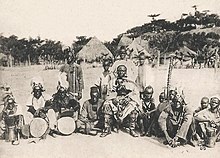|
Kissi people
The Kissi people are a West African ethnolinguistic group.[5] They are the fourth largest ethnic group in Guinea, making up 6.2% of the population.[6] Kissi people are also found in Liberia and Sierra Leone. They speak the Kissi language, which belongs to the Mel branch of the Niger–Congo language family.[7] The Kissi are well known for making baskets and weaving on vertical looms. In past times, they were also famous for their ironworking skills, as the country and its neighbors possessed rich iron deposits. Kissi smiths produced the famous "Kissi penny," The Kissi people are also called Assi, Bakoa, Den, Gihi, Gisi, Gissi, Gizi, Kisi, Kisia, Kisie, Kisiye, Kizi, or Kalen[8][9] HistoryAccording to The Peoples of Africa, Kissi tradition considers that before the seventeenth century, they inhabited the Upper Niger region. Supposedly, they lived south of the Futa Jallon until the Yalunka people expelled them. After 1600, they migrated westward, expelling the Limbas in their march, but were under constant threat from the Kurankos.[10] Resistance to French conquest by Kissi Kaba KeitaIn Guinea, the Kissi warrior Kissi Kaba Keita managed to unite many Kissi chiefdoms under his reign and resist French conquest for many years. Before French attacks, he had rallied the Kurankos of Morige and the Leles of Yombiro. When the French arrived in 1892, he had to let the relatively autonomous chiefs of the respective areas defend themselves. Due to the French's technological superiority, Kissi Kaba resorted mainly to guerilla tactics, thus delaying their conquest of his kingdom. Still, by 1893, he realized that his resistance would fail and subjected himself to the French, who recognized him as chief of the northern Kissi territory. However, his relationship with the French gradually worsened, leading to them appointing his rivals in several of his chiefdoms and eventually to his execution in Siguiri.  Religion and spiritual beliefsAlthough many Kissi have converted to Christianity, most continue practicing their traditional ethnic religion. Ancestor worship or praying to deceased relatives is common among the Kissi. The Kissi people produced many carved soapstone figures and heads before colonial contact with the Europeans. It is unclear why they were made; some scholars argue that they form part of ancestor worship, while others say they may represent gods to increase agricultural yields. A large number can be seen in the British Museum's collection.[11] Foryoh
Notable Kissi people
References
External linksWikimedia Commons has media related to Kissi people.
|
||||||||||||||||||||||||||||||
